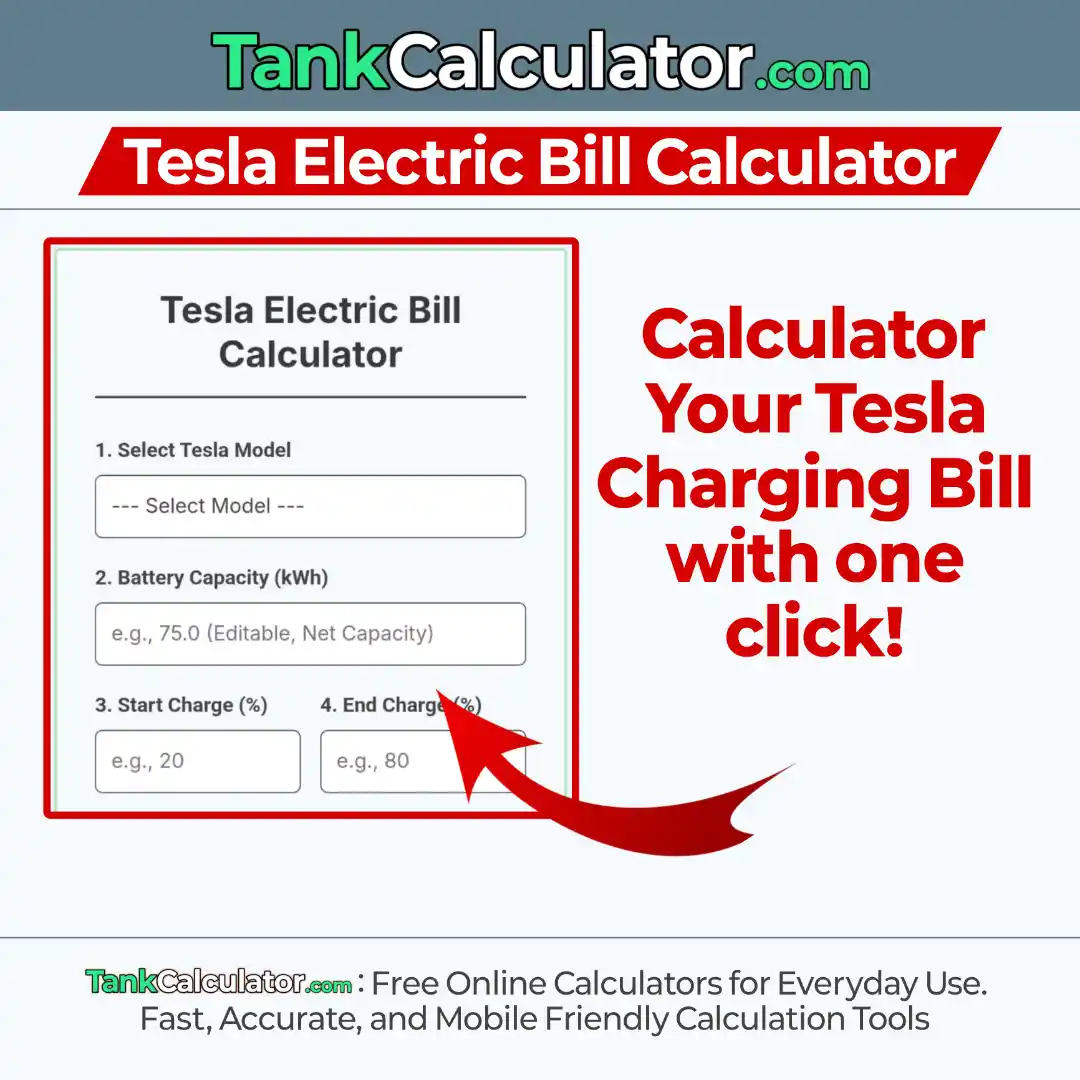To calculate Tesla electric bill, enter the following details given below:
Tesla Electric Bill Calculator
Charging Results Summary
| Charging Efficiency Loss | --- |
|---|---|
| Fixed Fee/Tax | --- |
| Net Energy Added to Battery | --- |
| Total Energy Drawn from Grid | --- |
| Estimated Range Added | --- |
| Total Cost | --- |
Quick Navigation:
How to Calculate Tesla Electric Bill Manually
You can easily estimate your Tesla charging cost by using a simple formula.
Formula:
- Charging Cost = Battery Capacity (in kWh) × Electricity Rate (per kWh)
If you’re not charging from 0% to 100%, adjust it for the percentage you’re actually charging:
Formula:
- Charging Cost = Battery Capacity × ((End % − Start %) ÷ 100) × Electricity Rate
Example:
- Tesla Model 3 battery capacity = 75 kWh
- Starting charge = 20%
- Ending charge = 80%
- Electricity rate = $0.15 per kWh
- Step 1: Calculate usable energy
- = 75 × ((80 − 20) ÷ 100)
- = 75 × 0.6 = 45 kWh
- Step 2: Multiply by electricity rate
- = 45 × $0.15 = $6.75
- Step 3: Add 10% charging loss
- $6.75 + ($6.75 × 0.10) = $7.43
Final Estimated Charging Cost: $7.43
That’s your manual Tesla charging cost simple but a bit time-consuming.
How to Use TankCalculator’s Tesla Electric Bill Calculator
Now forget the manual math and let our calculator do the heavy lifting!
- 1. Select your Tesla Model 3, Y, S, X, Cybertruck, or “Other.”
- 2. Enter battery capacity, start %, and end % or let the tool fill it automatically.
- 3. Add your electricity rate.
- 4. (Optional) Charging loss% or flat fee/tax.
- 5. Set your car’s efficiency or let the tool fill it automatically.
- 6. Select Your Efficiency Mode Type (km/kWh or mile/kWh).
- 7. Then Just “Calculate.” You’ll instantly see:
- Net energy added to your battery
- Total energy drawn from the grid
- Estimated range added
- Total charging cost
You can even print or export the results for easy tracking!
About TankCalculator’s Tesla Electric Bill Calculator
TankCalculator’s Tesla Electric Bill Calculator is a smart online tool designed to help EV owners estimate real-world charging costs in seconds.
Whether you’re charging at home or at a public station, it gives you a clear breakdown of how much energy your Tesla consumes, the cost per kWh, and the distance you’ll cover all in one clean dashboard.
Built for Tesla fans, homeowners, and eco-drivers, it’s perfect for anyone who wants to plan smarter, save energy, and stay informed.
Features of TankCalculator’s Tesla Electric Bill Calculator
This is what makes our calculator favorite among Tesla owners:
- Model Based Auto Inputs: Instantly loads Tesla battery and efficiency data.
- Real Time Cost Calculation: Get your total cost in seconds.
- Charging Loss % & Flat Fee Fields: Account for every hidden expense.
- Dual Efficiency Units: Switch between km/kWh and mile/kWh effortlessly.
- Instant Range Estimation: See exactly how far your charge will take you.
- Print & CSV Export Options: Save or share your charging report anytime.
Frequently Asked Questions (FAQ)
Is charging a Tesla really cheaper than petrol?
Yes. Charging a Tesla is generally less expensive than filling up a gasoline-powered car. The amount saved depends on the local electricity and petrol prices, plus driving efficiency. Electricity is cheaper on an average by 30% to 60% as compared to petrol.
How long does a Tesla battery last?
Generally, a Tesla battery has a life of about 300,000 to 500,000 kilometers (about 8-15 years) depending on the use, charging habits, and weather conditions. The capacity of the battery may be affected but will continue to be usable.
Does Tesla replace batteries for free?
In any case, a warranty offered by Tesla for the batteries allows for replacement or repair during an 8-year warranty period or until 150,000 miles are covered, whichever comes first. After that, the cost of battery replacement falls on the owner.
Can a Tesla be charged from a regular outlet?
Yes, you can charge a Tesla using normal 110 volt household plug (level 1 charging), but it is quite slow at around 3 to 5 mph. Faster charging is recommended with a 240 volt (level 2) charger or wall connector installation.
Is it cheaper to charge a Tesla via 110 or 220 volt?
The kWh price is the same-the electricity rate does not change-but the 220-volt charger is more efficient and faster, which means less energy loss and time to charge.
What is the lifespan of a Tesla charger?
With normal use, a Tesla wall connector lasts 10 to 15 years. Proper maintenance and ensuring that it stays dry and in the shade helps elongate its lifespan.
Is it alright to leave a Tesla plugged in overnight?
Yes, it is recommended by Tesla to plug in whenever possible. Charging stops automatically when full, so this is good for the battery.
Can a generator charge a Tesla?
Yes, provided that the generator produces clean, stable electricity and maintains Tesla’s voltage and amperage requirements. Mainly in emergencies; not a long-term charging means.

